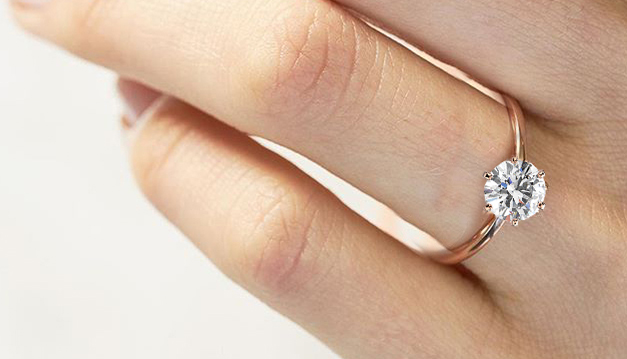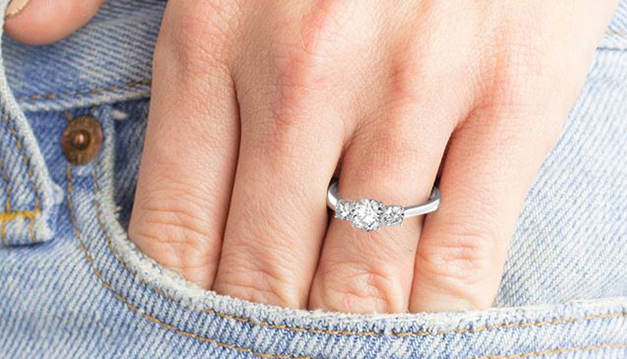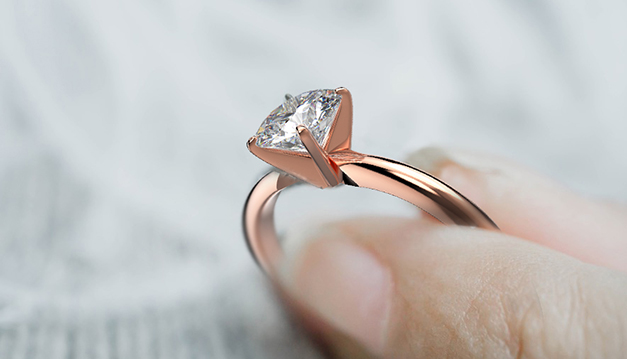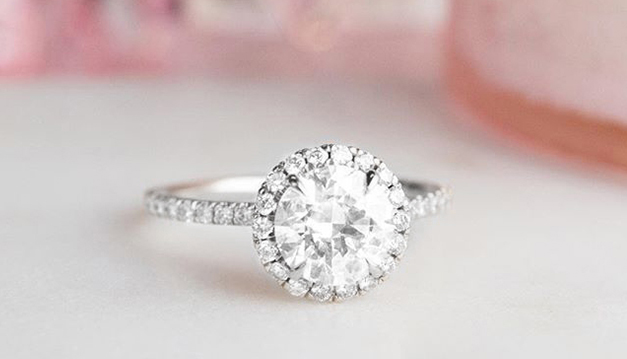Here’s a glossary of terms commonly used in the industry with reference to diamond cuts and properties.

Abrasion:
Tiny nicks along the facet junctions, producing white fuzzy lines instead of sharp crisp facet edges.
Asscher cut:
Fancy diamond with the shape of a square emerald cut. Developed in the early 1900s by
Baguette Cut:
A step cut in the shape of a small rectangular diamond. May be tapered on one end.
Bearding:
Tiny, numerous hair-like fractures extending into the diamond.
Bezel:
A facet on the crown, or upper part of the diamond, but the girdle.
Blemish:
Surface imperfection on a diamond.
Bort:
Industrial grade diamonds, diamonds not suited as jewels.
Bow Tie:
An effect caused by a shadowy areas visible in some fancy shapes (like ovals and pears), caused by light leaking out of the bottom of the diamond.
Brilliant Cut:
The most common cut, round, containing 57 or 58 facets, also called the Round Brilliant
Carat:
The metric “carat”, which equals 200 milligrams, is the standard unit of weight for diamonds and most other gems.
Certificate:
Laminated document by a gemological institute (ie. GIA, AGS, EGL) to describe a diamond’s characteristics.
Chip:
A tiny, missing piece, caused by normal wear and tear, or by cutting.
Clarity:
Also known as purity. A diamond’s relative position on a flawless to imperfect scale based on the number and location of imperfections inside the diamond. The clarity scale goes from FL-IF to varying degrees of imperfect.
Cleavage:
The propensity of crystalline minerals, such as diamond, to split in one or more directions, either along or parallel to certain planes, when struck by a blow. Cleavage is one of two methods used by diamond cutters to split rough diamond crystals in preparation for the cutting process. Sawing is the other method.
Color:
Color refers to the amount of body color a diamond has, most commonly yellow or brown, but also rarely in pink, green, blue, orange, and fancy yellow. The color of a diamond is an important characteristic because it is noticeable to the untrained eye.
Crown:
The portion of the stone above the girdle.
Culet:
The facet on the bottom of tip of the diamond. A diamond with no culet has a pointed tip. A diamond with a small culet has a flat surface at the tip. Culets can prevent chipping but can be less desirable when in the medium to large range. A diamond with a medium to large culet will appear to have a hole in the bottom when looking down the stone, through the table.

Cushion Cut:
A fancy cut with rounded corners and larger facets. Sometimes also referred to as a pillow cut.
Depth:
The height of the diamond from the culet to the table. The depth percentage listed on the certificate indicated the height of the diamond relative to the width measurement (height value, width value). A diamond which is too shallow or too deep will disperse light through the sides or the bottom instead of the top.
Emerald Cut:
Step cut diamond, usually rectangular shape and cut corners. The ideal length to width ratio of the emerald cut is between 1.5 and 1.7.
Eye Clean:
A diamond with no inclusions visible to the naked eye without the aid of a loupe.
Extra Facet:
A “false” facet, a facet placed without regard for symmetry and not required by the cutting style.
Facet:
A plane, polished surface of a diamond. The brilliant, a full cut round diamond, usually contains 58 facets.
Fancy:
A diamond with another shape other than round cut (ie. princess, emerald, oval, cushion etc.) and/or with an attractive natural body colour other than light yellow or light brown.
Feather:
A separation or break due to either cleavage or fracture, often white or feathery in appearance.
Flaw:
An imperfection in a diamond, see clarity.
Finish:
Refers to qualities imparted to a diamond by the skill of the diamond cutter. It covers every aspect of the diamonds appearance that is not a result of the diamond’s inherent nature.
Fluorescence:
A naturally occurring glow some diamonds exhibit under ultraviolet lighting conditions, normally bluish in color but can also be yellow.
Fluorescence Ratings:
None, faint, slight, medium, strong blue, very strong blue. Strong blue and very strong blue fluorescence may cause the diamond to appear milky in daylight. According to the GIA, only .2% of diamonds with fluorescence will exhibit a milky appearance in sunlight. Fluorescence can raise the color appearance by several grades and give a diamond a slight blue tint in certain lighting.
Fracture:
A crack on the diamond’s surface.
Girdle:
The outer edge of the widest part of the diamond, forming a band around the diamond. Some cutters also polish the girdle into facets for maximal reflection.

Grain:
A small area of concentrated crystal structure distortion, usually associated with pinpoints.
Hardness:
Mineral’s resistance to scratching on a smooth surface. Measured on the Mohs scale of hardness ranging from 1-10. Diamond measure 10 on the Mohs scale and is the hardest of all gemstones.
Heart Cut:
A type of fancy diamond cut, which is cut ot resemble the popular Valentine’s Day shape. Inclusion: Imperfection internal to the diamond, the unique “birthmark” of a diamond. Inclusions tend to viewed with a 10x loupe, or greater, and affect the diamond clarity. No two diamonds have the same position, size, and colour of an inclusion.
Internal Graining:
Internal indications of irregular crystal growth. May appear milky, like faint lines or streaks, or may be coloured or reflective.
Kimberlite:
Complex, pipe-shaped mixture of rock material, formed by solidifying volcanic magma. Not the actual source for diamonds, but the “elevator” that brings them to the Earth’s surface. The name is derived from South Africa's Kimberly Mine, where this phenomena was discovered.
Knot:
An included diamond crystal which reaches the surface of a polished diamond.
Laser Drill Hole:
A tiny tube made by a laser to remove an inclusion, noticeable on clarity enhanced diamonds. The surface opening may resemble a pit, while the tube usually looks needle like.
Laser Identification:
Microscopically smaller superficial inscription created by a laser on a diamond for identification. Relatively easily to remove by polishing.
Marquise Cut:
A modification of the brilliant cut, it is a boat shape, elliptical and pointed at both ends. It is sometimes described in old valuations as Navette.
Melee:
Small diamonds under .20 carat, usually .10 carat or under, often as small as .8mm in diameter. Can be either fully faceted with 57 facets or single cut.
Natural:
Part of the rough diamond remaining on a diamond, having survived the cutting process.
Needle:
A long, thin included crystal which looks like a tiny rod.
Oval Cut:
Cutting shape of a diamond, oval with facets.
Pavillion:
The lower portion of the diamond, below the girdle.

Pear Shape Cut:
Also referred to as tear drop shape.
Pit:
A tiny opening, often looking like a white dot.
Points:
Pts, 1pt is 100th of a carat, or 0.01ct, like a penny to a dollar.
Polish Lines:
Tiny parallel lines left by polishing. Fine parallel ridges confined to a single facet, caused by crystal structure irregularities, or tiny parallel polished grooves produced by irregularities in the scraped surface.
Polish Marks:
Surface clouding caused by excessive heat (also called burn mark, or burned facet), or uneven polished surface resulting from structural irregularities.
Premier:
A diamond with a yellowish body colour which is masked by a strong blue fluorescence. The diamond will appear whiter than it actually is, but could have an oily or milky appearance in daylight or fluorescent light. The value of the stone is reduced.
Princess Cut:
Normally a square diamond with a faceted base. It is the square equivalent to a round brilliant.
Radiant Cut:
A type of brilliant cut fancy shape that resemble a square or rectangle with the corners cut off.
Ratio:
A comparison of how much longer a diamond is than it is wide. Used to analyze the outline of fancy shapes. Not applied to round diamonds.
River:
Infrequently used reference for the colour of a diamond, ie River = D and E white. River refers to the colour D, exceptionally white.
Round Cut:
The most common cut, usually containing 58 facets. Also the most brilliant cut in terms of the most efficient use of light to increase brilliance and fire, hence the name “brilliant”.

Rose Cut:
A stone cut with a flat base, with the upper facets cut to a point. Normally encountered in antique jewelry starting with the 17th century, but making a comeback in the last few years.
Scratch:
A linear indentation normally seen as a fine white line, curved or straight.
Simulant:
Any diamond-like material, either natural or artificial, which is marketed as a look-alike for a natural diamond. ie, glass, zirconium, YAG, GGG, moissanite, etc. Not to be confused with synthetic.
Single Cut:
A very small round diamond with only 16, 17, or 18 facets, instead of the normal 57 or 58 facets of a full cut round brilliant. Used mostly for pave jewelry.
Spread Cut:
A diamond with a large table and a thin crown height.
Step Cut:
One of three styles of faceting arrangements with three concentric rows of facets arranged around the table and three concentric rows around the culet. Baguette cuts (straight or tapered), emerald cuts, and asscher cuts are all step cuts.
Surface Graining:
Surface indication of structural irregularity. May resemble faint facet lines, or cause a grooved or wavy surface. They often cross facet junctions.
Synthetic Diamond:
Man made, or lab grown, unlike a simulant, has the identical chemical composition and crystal structure as the natural counterpart.
Symmetry:
Describing small variations in a diamond’s symmetry, such as misalignment of facets or facet that fail to point correctly to the girdle. An indicator of the quality of the diamond’s cut, graded as either ideal, excellent, very good, good, fair, or poor.